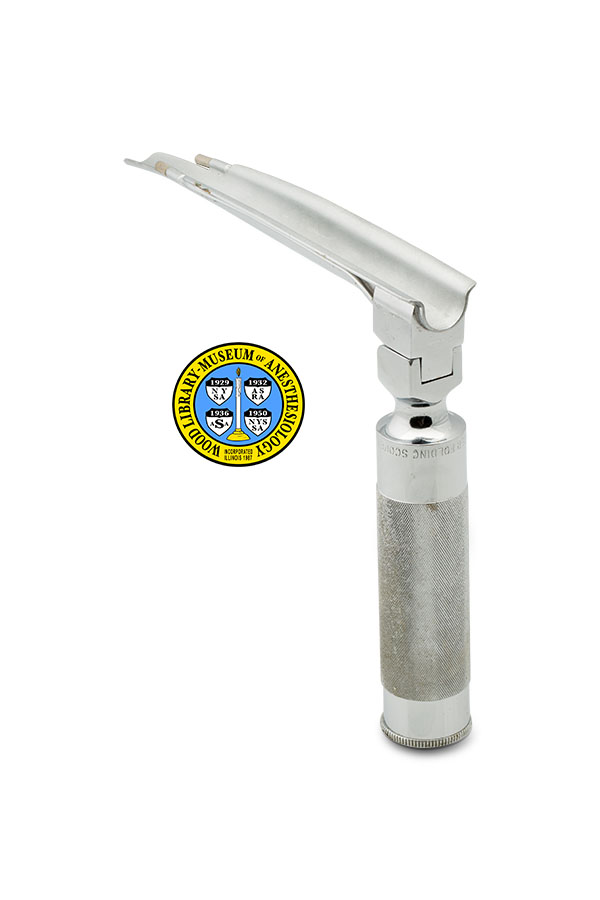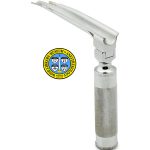Searles Laryngoscope
Anesthesiologists may use a laryngoscope in order to view the patient's larynx (voice box) and insert a breathing tube into the trachea (windpipe). This is assisted by a built-in battery-operated light. Paul W. Searles, M. D. (1908-1995) worked as a professor of anesthesiology at the University of Buffalo School of Medicine, and at the University of Illinois College of Medicine. He noted that beginning medical students "were frequently confused as to which hand to use with the laryngoscope, and which hand to use to pass the endotracheal tube."
To solve this problem, he introduced his laryngoscope blade in 1950. It was designed to be equally easy to use with the right hand or the left. Instead of the usual single lightbulb, it had two, one on each side of the blade. The Searles laryngoscope was made by The Foregger Company, of New York, from 1950 through the mid-1970s. It was a modification of that introduced in 1943 by James H. Bennett, M.D. (b. 1904). The Bennett blade was also made by the Foregger Company.
Catalog Record: Searles Laryngoscope Searle Laryngoscope
Access Key: aqlf
Accession No.: 2004-03-03-1 H
Title: [Left & Right Searle / Foregger Company]
Author: Searles, Paul W. (Wesley), 1917-1981.
Corporate Author: Foregger Company.
Title variation: Alt Title
Title: Searles Left & Right Laryngoscope
Subject: Airway Management – instrumentation.
Subject: Anesthesia, Intratracheal – instrumentation.
Subject: Laryngoscopes – battery-powered.
Subject: Laryngoscopes – curved blades.
Note Type: General
Notes: The first year in the date range is based on the year of introduction. The second year in the date range is based on the date that the object was acquired.
Married to handle, accession # 2004-03-03-1 H for purposes of photography.
Note Type: Citation
Notes: Burkle CM, Zepeda FA, Bacon Dr, Rose SH. A historical perspective on use of the laryngoscope as a tool in anesthesiology. Anesthesiology. April, 2004;100(4):1003-1006.
Note Type: Citation
Notes: Paul W. Searles Manuscript Collection. Archives: Located at: Wood Library-Museum of Anesthesiology, Schaumburg, Illinois.
Note Type: Citation
Notes: Searles PW. A modified laryngoscope blade. Anesthesiology. November, 1950;11(11):750-751.
Note Type: Citation
Notes: Searles, Paul W. [biographical file]. Archives. Located at: Wood Library-Museum of Anesthesiology, Schaumburg, Illinois.
Note Type: Citation
Notes: U. S. Army Medical Department, Office of Medical History website. http://history.amedd.army.mil/booksdocs/wwii/orgadmin/org_admin_wwii_chpt8.htm. Accessed November 10, 2017.
Note Type: Physical Description
Notes: One laryngoscope blade; The blade is straight for most of its length, with a long, very slight downward curve at the tip; The trough of the blade is wide, being deepest at the back below the hub and becoming progressively shallower toward the tip; A channel for the electrical connection runs under the flattened flange of the blade on either side, emerging on the inner side of the blade; Each of these ends in a battery-operated light bulb; The concave interior of the blade has a rough texture in contrast to the polished chrome on the exterior;
The blade has a snap-on hub that allows the blade to be folded down against the handle when not in use; It is stamped on the right side of hub: “LEFT & RIGHT SEARLE”; It is stamped on the bottom of the hub: “PATENT PENDING”; It is stamped on the left side of the hub: “FOREGGER”; Letters are so incompletely stamped on the back of the hub as to be illegible; There are some several scratches on the underside of the blade.
Note Type: Reproduction
Notes: Photographed by Mr. Steve Donisch, June 20, 2017.
Note Type: Acquisition
Notes: Gift of Vance Lauderdale, M.D.
Note Type: Historical
Notes: Anesthesiologists may use a laryngoscope to view the patient’s larynx (voice box) and insert a breathing tube into the trachea (wind pipe). This is assisted by a battery-operated light that is built into the device. Native Minnesotan Paul W. Searles, M. D. (1908-1995) received his medical degree from the University of Minnesota, and his post-graduate training in anesthesiology from John S. Lundy, M.D. (1894-1973) at the Mayo Clinic. His service on active and reserve duty in the U. S. Army spanned 38 years; he retired with the rank of Colonel.
Dr. Searles was a professor of anesthesiology at the University of Buffalo School of Medicine. He also served as the first President of the New York Society of Anesthesiologists, and as Chairman of the American College of Anesthesiologists. He was a professor of anesthesiology at the University of Illinois College of Medicine. While in Chicago, he also served as Commander of the 801st Army General Hospital.
As a teacher, he noted that beginning medical students “were frequently confused as to which hand to use with the laryngoscope, and which hand to use to pass the endotracheal tube.” To solve this problem, he introduced his laryngoscope blade in 1950. It was designed to be equally easy to use with the right hand or the left. Instead of the usual single lightbulb, it had two, one on each side of the blade.
Searles stated “The tip of the blade is narrow and curves backward. This allows for easy access to the epiglottis…. and also lifts the epiglottis without excess pressure on the base of the tongue.” The Searles laryngoscope was made by The Foregger Company, of New York, from 1950 through the mid-1970s. The Searles blade is a modification of that introduced in 1943 by fellow Minnesota native James H. Bennett, M.D. (b. 1904). The Bennett blade was also made by the Foregger Company.
Note Type: Exhibition
Notes: Selected for the WLM website.


